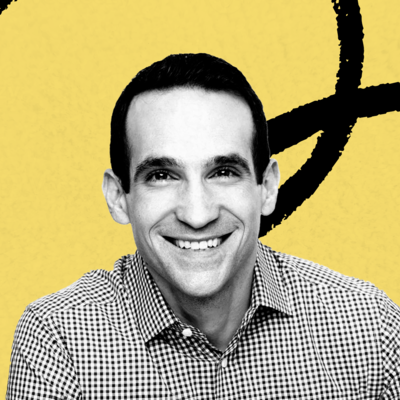
Sponsored By: Maven
This essay is brought to you by Maven.com, the home of career-building cohort-based courses that help ambitious professionals to level up, get promoted, and build new skills.
Nerves almost killed Nike before it got off the ground.
At 26 Phil Knight was running a growing sneaker business importing Japanese-made running shoes to America. He’d found a sneaker in Japan called Tigers that were lighter and faster than anything on the U.S. market. He was partnered with Olympic coach Bill Bowerman, and he’d figured out a sales strategy that meant he was taking orders faster than he could fill them. “I was on a roll,” he said.
Until the letter arrived, and his business imploded.
The letter was from a man, just back from meetings in Japan, who claimed that he was now the exclusive distributor of Tiger sneakers in America. “Since he’d heard that I was selling Tigers, I was therefore poaching, and he ordered me—ordered me!—to stop.”
Phil didn’t take the news well. He was a self-described shy, pale, rail-thin kid who couldn’t handle rejection. “I went into a deep funk. Each night I’d sit with my family at dinner, moving my mother’s pot roast and vegetables around my plate. Then I’d sit with my father in the nook, staring glumly at the TV.” He considered going back to selling encyclopedias door to door.
He wrote letters to Onitsuka, the Japanese company who manufactured Tigers asking them to change their mind, but got no response. After a few months of waiting, he’d basically given up on the idea of selling shoes at all.
But then at the end of summer of that year, he had a change of heart:
“[I had a] Crazy Idea, and somehow, despite being dizzy with existential angst, and fears about the future…I [decided] that the world is made up with crazy ideas.”
He realized that he couldn’t give up. And he decided to fly back to Japan to force a meeting with Onitsuka. And that’s exactly what he did. He flew back, got a meeting with the manufacturer, and convinced them to grant him the rights to sell Tigers on the West Coast.
Phil Knight was back in business—and Nike was about to take off. The rest, as they say, is history.
Stories like this are dramatic examples of how your ability to achieve your dreams is shaped largely by your willingness to face your fears. It might seem like these situations only arise in rare, crucial moments. But Phil Knight’s choice to face his fear is just a larger-than life version of a choice you make all the time. If I had to bet, though, you’re probably choosing to give up and sell encyclopedias more often than you realize.
You might think you don't get afraid that often. You go through life and do the things you need to do, some of it unpleasant but important so you do it anyway. But true fear? That's for special occasions.
If that sounds like you, I encourage you to ask yourself: do you not experience fear often because you are just that fearless, or is there another reason? Perhaps fear is kept away because you subtly, perhaps even unconsciously, avoid situations that would make you afraid? If you're like 99% of most human beings (spoiler: you probably are) then most of the time it's the latter.
How many Nikes didn’t even get far enough to get sued because the person who could’ve started it was too afraid to think it up in the first place? How many of your own potential projects, potential relationships, potential creations have suffered the same fate?
In short, whether you realize it or not, avoidance of fear is one of the biggest things holding all of us back in our lives. And so developing a quality of courage in the face of fear is a key path to creating the lives we want.
Fortunately, there are well-understood methods that can help you courageously face your fears as effectively as possible. Let's talk about what they are.
If you’re looking to upskill as a marketer, check out Maven’s selection of marketing-related courses.
You can learn B2B Marketing from the ex-Head of Marketing at Asana or about Brand Strategy from an expert at First Round Capital.
Becoming fearless
Let’s say you want to figure out how to become fearless. Where do you start?
You could look for a population of people who have no fear, and try to understand the structure of their brains. Maybe, for example, looking at the amygdala of Alex Honnold—who spends his days equanimously scaling sheer cliff faces without ropes—might help tell you about how fear works in the brain and what we might do to eliminate it.
I think a better place to look, though, is in populations of people who used to have a lot of fear, but now don’t. The key is finding people who have accomplished a transition from fear to no fear. If you’re looking for a population like that, I think people who have OCD are a great place to start.
OCD is interesting because people, like me, who suffer from it are constantly experiencing thoughts that are extremely scary to them—that’s the “obsessive” part of OCD. Recovery from OCD doesn’t involve eliminating the scary thoughts, it involves being able to have the thoughts without avoiding them. It's about learning to develop courage in the face of extreme fear. This kind of consistent courage works, over time, to significantly reduce fear—even when you’re in contact with the worst of what your mind can imagine.
This is done through a well-researched empirically-backed protocol called Exposure and Response Prevention (ERP), or simply exposure. The practice of exposure follows from what we already know about fear: the best way to get over fear is to face it. But it turns out that not all exposure is created equal—there are ways to effectively optimize your exposure so that you can maximize your chances for actually reducing your fear and making sure it doesn’t come back.
So how does this actually work? Well, you might think that reducing your sense of fear is about, for example, learning how to relax or meditate better so that things don’t feel as bad. Or that it’s mostly about habituation—basically, putting yourself into contact with something you fear for as long as it takes for it not to provoke a reaction anymore. But according to science these are probably both wrong.
The most current thinking around what facilitates long-term fear reduction is actually learning. Effective exposure is about maximizing the amount of learning you’re doing while contacting the thing you fear.
This has some key implications for how exposure should be done, and what kind of results can be expected from it. For example, this model of exposure emphasizes the importance of surprise—or expectancy violation. The bigger the difference between what you expect to happen during an exposure, and what actually happens—the more likely you are to learn that the thing you’re afraid of is actually safe.
Another interesting implication is that it’s important to do exposure in multiple contexts because fear learning is generalized, while safety learning is usually context specific. So the more sets and settings within which you can do an exposure the more likely you are to strengthen the safety learning.
Becoming courageously facing your fears is part science and part art. In the rest of this piece I’ll go through what the science says about how exposure works to reduce fear, and how to do it effectively.
NOTE: If you’re suffering from actual clinical anxiety, trauma, or OCD you should really do this with a therapist first before doing it on your own. I’m not a therapist or a doctor, I’m just a guy on the internet with deep interest in these topics and who has been doing exposure myself for a long time. This article is for educational purposes only, and it’s possible that I’ve gotten things wrong. Proceed with caution and at your own risk!
Word to the wise: exposure is done with stimuli that are scary but not overwhelming—if it’s done incorrectly you could accidentally make things worse.
The modern science of exposure
You can see the principles behind exposure already at work in pre-scientific traditions going back thousands of years.
For example, the 13th century Persian mystic Rumi sums up exposure quite nicely: “Don't turn away. Keep your gaze on the bandaged place. That's where the light enters you.”
Another great historical example are the Stoics, who emphasized the idea of voluntary discomfort in which they subjected themselves to temporary conditions of poverty or purposefully invited social rejection in order to harden themselves against fear. Here’s Seneca:
“Set aside a certain number of days, during which you shall be content with the scantiest and cheapest fare, with coarse and rough dress, saying to yourself the while: ‘Is this the condition that I feared?’ It is precisely in times of immunity from care that the soul should toughen itself beforehand for occasions of greater stress, and it is while Fortune is kind that it should fortify itself against her violence.”
It turns out there is a surprising amount of overlap between this Stoic practice and what modern science says is important about effectively facing your fears. Notice how the question, “Is this the condition that I feared?” is explicitly bringing to mind the difference between the expectation of what it might be like to live cheaply and the reality of that experience—which is precisely what is hypothesized to create the kind of learning that inhibits fear.
Over the last 75 years modern psychology and neuroscience has taken up the mantle of these traditional practices to try to understand what makes them work—so that they can be optimized as much as possible.
Modern exposure traces its roots to a South African psychiatrist named Joseph Wolpe. Wolpe was a behaviorist who is most famous for coming up with the idea of “systematic desensitization”.
In systematic desensitization an anxious client is gradually exposed to a stimulus that evokes anxiety at higher and higher levels. At each level the client faces their fear until the stimulus no longer evokes a reaction, at which point the intensity level of the stimulus is increased.
This model of exposure relies on the idea of habituation. An exposure is “working” to the extent that, during a session you experience a reduction of fear to something that was previously scary. In that sense, in-session fear reduction becomes both the goal of exposure, and is theorized to predict that over the long-term your fear won’t come back.
Makes sense, right? Unfortunately, the story is way more complicated than this. Over years of research, psychologists have found a few problems with the habituation model.
First, they’ve found that if you make fear reduction the goal of exposure you get weird paradoxical effects. Clients become very attuned to whether or not their fear is going down, and if it doesn’t go down in a session they’re likely to feel like they’ve “failed”. Sometimes in these cases fear itself becomes something to fear—which then increases the amount of fear they’re experiencing.
Second, they’ve found that in-session habituation doesn’t necessarily predict long-term fear reduction. There are cases where fear doesn’t attenuate in-session, but it does seem to go down afterward. There are also cases where fear does go down in-session, but then recurs later on.
In order to explain these phenomena, psychologists developed the “inhibitory learning model” to explain how long-term fear reduction actually works. It solves for some of the strange problems we find with the habituation model, and introduces a new focus for exposure sessions:
Rather than aiming for fear reduction, exposures should aim for surprise.
The idea with the inhibitory learning model is that success in exposure is a function of learning: you learn that something you previously thought was unsafe is in fact safe. This is theorized to happen by the creation of a new safety memory in the brain that competes with but doesn’t erase your original fear memory.
So, when you do exposure you don’t actually get rid of fear memory. You’re just inhibiting its activation, because your brain is now more likely to activate the safety memory than it is the fear memory.
Optimal exposure involves creating a safety memory in the brain, and working to strengthen that memory as much as possible so it is more and more likely to get activated over time. What follows is a step by step guide for how to do that.
ANOTHER NOTE: If you’re suffering from actual clinical anxiety, trauma, or OCD you should really do this with a therapist first before doing it on your own. I’m not a therapist or a doctor, I’m just a guy on the internet with deep interest in these topics and who has been doing exposure myself for a long time. This article is for educational purposes only, and it’s possible that I’ve gotten things wrong. Proceed with caution and at your own risk!
A basic exposure practice
Exposure is complex and there are many different ways that it can be done. But I want to explain a simple exposure practice—and break down how it works—so that you can modify and apply it in different situations in your life.
First, bring to mind something that’s evoking some amount of anxiety. Maybe it’s a dreaded pitch meeting, a job interview, or the feeling you get when you notice your startup’s runway slowly decreasing month over month.
One way to expose yourself to this fear would be to actually put yourself in the dreaded situation. But sometimes that's costly and impractical, and maybe it's so anxiety-inducing that it helps to start with something safer. So instead, we're simply going to create a vivid scene in our imagination where we put ourselves in the situation we’re dreading.
As it turns out, simply imagining scary things can activate the same fear and avoidance reactions as as experiencing the scary thing itself, so exposure to imagined experiences works in much the same way as exposure to the real thing. The main outcomes we're looking to drive are:
- Making the thing in your imagination hook you less
- Learning that you can tolerate the feelings of doubt and uncertainty you’re experiencing
- Making it easier to face the thing in reality
- Ultimately, reducing your fear
Ready to get started? Let’s go.
What do you fear?
The first thing to do is make a list of the thoughts, feelings, or situations that are provoking a fear response in you.
The key thing to figure out here is: what is the bad outcome that my thoughts and fears are predicting will happen?
Maybe it’s getting rejected by an investor after a pitch meeting. Or maybe it’s your startup running out of money. Pick something that’s causing you some angst, but not something that is legitimately traumatic. As noted up top, when you’re dealing with trauma or a clinically significant issue doing exposure alone isn’t recommended. So if you’re doing this alone, keep it to stuff that’s uncomfortable, but not overwhelming.
Once you know what your bad outcome is, try to think about what you think might precede or predict it. For example, going back to being rejected by an investor, maybe it’s being really nervous during the pitch, or stumbling over your words, or the investor being disinterested during your conversation and checking their email.
Don’t worry so much about getting the details of this exactly right—there’s no one right answer here. You can adjust and change as you get more used to this exercise to find what works best for you.
Once you have this down, it’s time to move on to safety behaviors.
What are your safety behaviors?
Exposure only works if we learn to stop avoiding our fears, and instead make contact with them willingly and directly.
That means in order for exposure to work best we have to stop doing safety behaviors that we might normally resort to in order to reduce our level of fear.
For example, if you pay attention to what happens when you start to think of your startup running out of money, you’ll probably find some interesting patterns. You might notice yourself start to ruminate. Maybe you’ll go around and around about new growth strategies, or maybe you start to berate yourself for bad decisions you’ve made in the past.
The rumination is a safety behavior. Your mind is trying to solve the problem in front of you, and thereby reduce your fear. In some contexts, this might actually be quite helpful. But in the context of exposure it’s best to put it to the side—the idea isn’t to solve your problem, it’s to make contact with your thoughts about the problem directly so that you can learn that you can handle them needing to resort to a safety behavior.
If you do exposure and then immediately do a safety behavior—like rumination—you’re not giving yourself a chance to realize that the thing you were afraid of is not likely to happen, and that you can handle the uncertainty of the idea that it might. So you’re stopping your natural learning process from happening—you’re allowing your brain to conclude that the safety behavior is keeping the bad thing from happening.
You might have other safety behaviors aside from rumination. Maybe when you have an upcoming pitch meeting you grab a drink to take the edge off, or eat a lot of carbs. Whatever your safety behaviors are it’s crucial that you identify them because in order for exposure to work you need to stop doing them in the presence of the thing you fear (at least during the exercise.).
What do you expect?
Exposure is hypothesized to work by expectancy violation, so it’s useful to make clear what you expect to happen before you do an exposure.
In particular, ask yourself what do you expect will happen if you make contact with a distressing thought without resorting to safety behaviors?
Will it just be a bunch of pain? Will it make things worse? Will it be useless? Take a few moments to write down what you expect before you begin.
Doing an exposure
Once you know what you expect, it’s time to conduct an exposure. Choose a specific amount of time that you want to get in touch with the thing that’s troubling you—10-20 minutes is probably a good start, but you can start lower if that feels better.
Sit alone in a quiet room in a chair or on a meditation cushion. Pay attention to your breath for a minute or two in order to gather your thoughts and quiet your mind. Then start your timer.
Bring to mind whatever the distressing outcome is that you’ve selected for this exposure. The key here is to vividly imagine the scene that predicts your dreaded outcome as much as possible. (If it’s hard to do this in your mind, try writing it out first and then reading it as a script.)
Sit still with it. Watch what happens when the thought comes to mind.
What does your mind do? What other thoughts, emotions, or images show up? What happens in your body? The key here is to sit with whatever happens without running or trying to avoid them in any way. Just observe whatever is happening directly.
Let your attention flow towards whatever is distressing, and make room for it as willingly as you can. Try not to push any of it away, or to distract yourself. Remember that this is only a short exercise, and you can return to distractions or other comforting thoughts as soon as the exposure is done.
When the timer goes off, the session is over. Give yourself a little bit of credit—no matter what just happened, you spent time facing your fears.
Reflecting post-exposure
Once you’re done with your exposure, spend a few minutes reflecting on the experience. Here are a few questions that might guide your reflections:
- What were your general observations about the experience?
- Did anything surprise you?
- Was there any difference between what you expected to happen and what actually happened?
- How could you use what you learned in this experience to guide your behavior when these thoughts come up in the future?
What happens when it works
What you are doing here is not teaching yourself that you don’t care about the worst possible thing happening. The goal isn’t to always be calm.
It’s to learn to feel fear and move through it without avoiding it. Along the way, you’ll learn that many of the thoughts, feelings, and situations that seem to predict your worst fear coming true—don’t actually increase its likelihood that much. You’ll learn that you can handle those things when they happen because you’ve practiced willingly bringing them up yourself time after time.
In my experience, it’s that willingness that makes the key difference. When I’m truly willing to feel the emotion, whatever was troubling me feels a little bit less imminent, and a little bit less sticky than it did before—and I’m able to move through it more fluidly.
Sometimes, though, something deeper happens. Usually, this happens when I’m feeling calm and spacious when I sit down and close my eyes. I’ll bring to mind a troubling thought, and it’s like dropping concentrated red dye into a calm tank of water. I can see the thought rippling through my body, increasing my heart rate, and making my palms sweat.
Normally this would be something I’d want to turn away from. But in these moments, I don’t even really feel like “my” heart rate is increasing—I’m somewhere else observing the water that is my body and the thought rippling around it.
Gradually, I drop more and more thoughts into this tank of experience—the water gets more and more red, and begins to froth. And then, in a flash, I “see” through the thought. It becomes almost holographic.
And thereafter, it no longer sticks. When I have it later on, it’s lost its substance. It still might be something that I want to avoid if possible, but I’m no longer afraid. It’s unhooked from my nervous system.
That’s the road to true fearlessness. It's paved with courage and willingness.
Recommended Reading
If you're interested in learning more about this here are a few books and articles that can help you deepen your understanding.
Books
Research Papers
- Maximizing Exposure Therapy: An Inhibitory Learning Approach
- Optimizing exposure therapy with an inhibitory retrieval approach and the OptEx Nexus
- Pharmacology of Cognitive Enhancers for Exposure-Based Therapy
Articles
If you see something in this piece that should be corrected, please hit reply and let me know! I tried my best to make sure everything reflected the current science, I'm always on the lookout for mistakes.
The Only Subscription
You Need to
Stay at the
Edge of AI
The essential toolkit for those shaping the future
"This might be the best value you
can get from an AI subscription."
- Jay S.
Join 100,000+ leaders, builders, and innovators

Email address
Already have an account? Sign in
What is included in a subscription?
Daily insights from AI pioneers + early access to powerful AI tools










Comments
Don't have an account? Sign up!